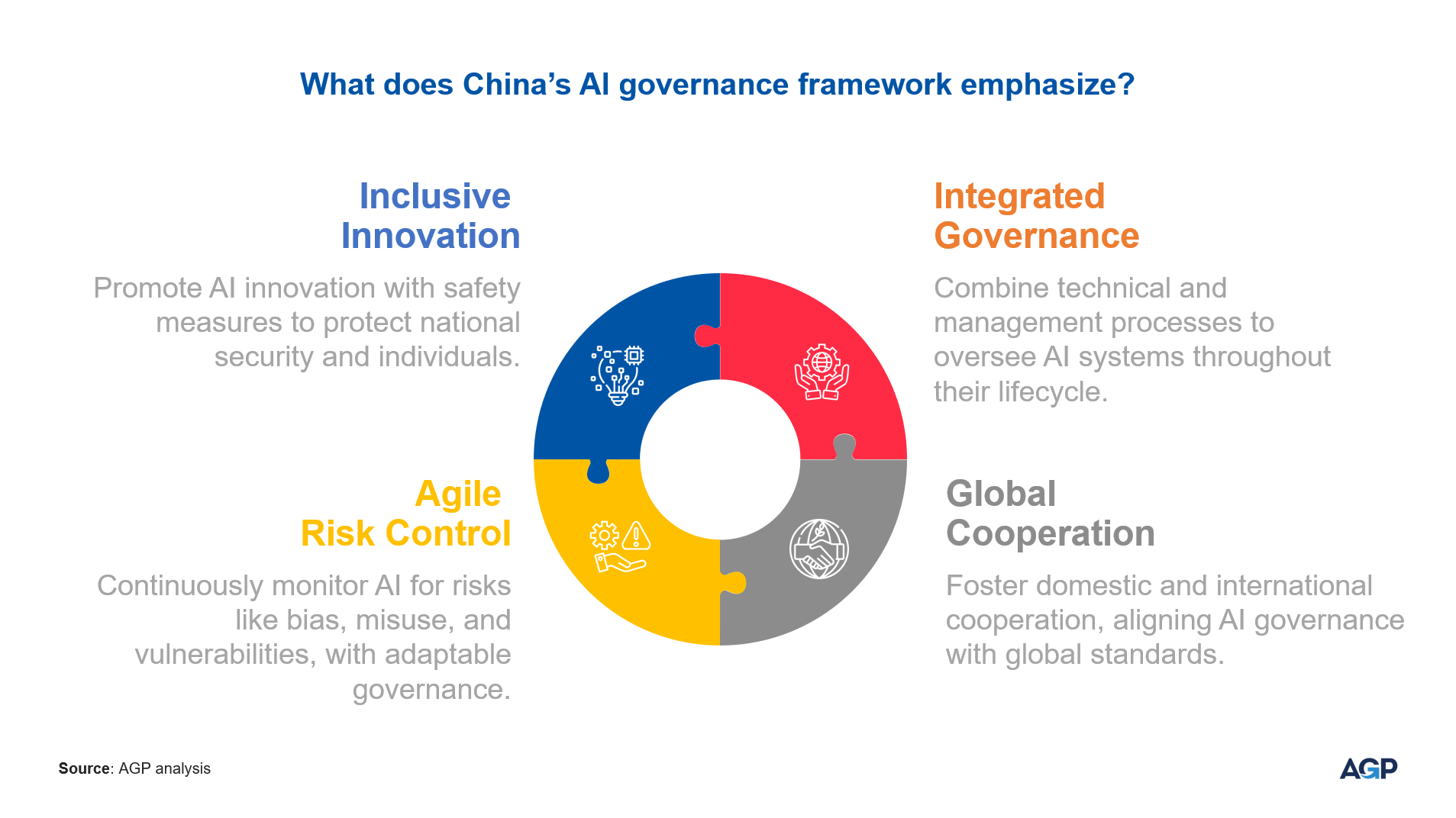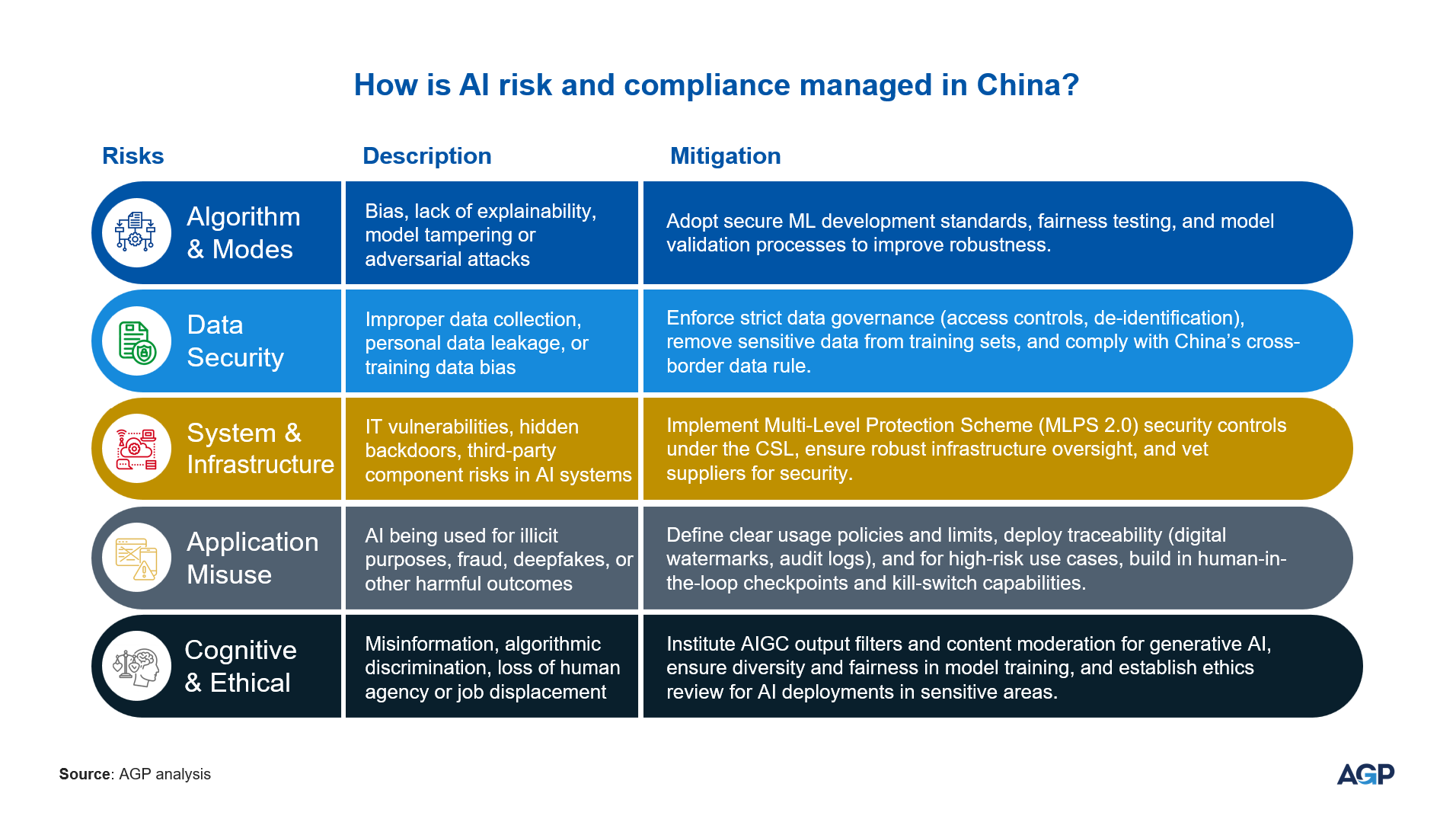Navigating AI Governance in China: What You Need to Know
China has moved at remarkable speed to weave Artificial Intelligence (AI) into core industries, from financial services and healthcare to manufacturing and mobility. But while its ambition is to lead globally in AI, the government has been equally clear: growth cannot come at the expense of national security, social stability, or data sovereignty. The resulting governance model is both strict and enabling. It aims to accelerate adoption while ensuring some guardrails, a duality that foreign multinationals (MNCs) must carefully navigate if they want to innovate and compete in China.
Download the full report filling up the form at the bottom.
Why Governance Matters in China
China’s AI regulatory framework rests on three foundational laws: the Cybersecurity Law (CSL), Data Security Law (DSL), and Personal Information Protection Law (PIPL).
These laws form the backbone of how companies must manage algorithms, data flows, and user rights. Together they create a uniquely Chinese governance regime that combines compliance obligations with political imperatives such as data localization and cross-border controls.
This model is unlike the EU’s AI Act, which is heavily focused on ethical safeguards, or the U.S.’s NIST AI Risk Management Framework, which prioritizes voluntary standards. China’s approach is state-led, security-first, and lifecycle-based, meaning companies must build governance into every phase of an AI system, from data collection to deployment and monitoring.
For MNC executives, this means AI adoption in China cannot be a simple copy-paste of global models. Governance decisions, whether around development, hosting, or data storage, must account for local rules first, and then be reconciled with headquarters’ frameworks.
China’s Governance Principles: Four Pillars
The framework, introduced in late 2024, lays out four organizing principles:
- Inclusive Innovation. Encouraging rapid AI development but balancing it with safeguards for national security and individual rights.
- Agile Risk Control. Monitoring continuously for bias, misuse, or vulnerabilities, with adaptable oversight mechanisms.
- Integrated Governance. Combining technical measures (auditing, explainability, traceability) with management processes across the AI lifecycle.
- Global Cooperation. Aligning with international standards where possible, but ensuring domestic priorities remain central.
For companies, this means innovation is welcome, though within clearly demarcated guardrails. Those who treat compliance as a box-ticking exercise risk delays and reputational damage. Those who embrace governance as part of their innovation strategy often gain speed, scale, and trust with both regulators and customers.

Responsibilities Across the Ecosystem
Governance responsibilities in China are distributed across the AI value chain:
- Developers must embed ethics, robustness, and resilience at the design stage.
- Service providers must disclose usage, obtain user consent, and manage real-time risks.
- Critical users are expected to conduct audits and maintain human oversight on high-stakes decisions.
- General users are increasingly trained to recognize risks, protect data privacy, and use AI responsibly.
Many MNCs operating in China now form AI Governance Committees that bring together IT, data science, risk, compliance, and legal teams. These committees set policy, evaluate projects, and ensure alignment between global frameworks and Chinese requirements. They also act as translators between headquarters and local regulators, a role that is becoming strategically vital.
Managing Risks: From Algorithms to Ethics
China’s regulators emphasize risk management in five key domains:
- Algorithms & Models – risks of bias, tampering, and adversarial attacks.
- Data Security – improper collection, leakage, or biased training sets.
- Infrastructure – IT vulnerabilities, hidden backdoors, third-party risks.
- Application Misuse – illicit purposes, deepfakes, or fraud.
- Cognitive & Ethical Risks – misinformation, discrimination, job displacement, or erosion of human agency.
Mitigation practices include secure machine learning development, fairness testing, human-in-the-loop oversight, and digital watermarking for generative AI outputs.

Implementing Governance: A Five-Phase Journey
According to AGP’s study, companies successful in China follow a five-phase methodology:
- Strategy & Assessment – Align AI governance scope with innovation goals, regulatory safety, and inventory of use cases.
- Framework Design – Define governance structures, roles, SOPs, and benchmarks aligned with both Chinese and global standards.
- Process Implementation – Create approval workflows, traceability tools, compliance automation, and explainability dashboards.
- Deployment & Enablement – Make architecture decisions (onshore vs. offshore vs. hybrid), set up localized infrastructure, file regulatory assessments, and train users.
- Monitoring & Improvement – Continuously track KPIs such as bias, performance, and ROI; update policies; and foster a culture of responsible AI.
This staged approach reflects a key lesson: governance is not a one-off project but an ongoing discipline.
China vs. Headquarters: The Development Dilemma
One of the toughest strategic choices for MNCs is whether to develop AI solutions in China or at headquarters. Our research highlights multiple factors:
- Data Location & Compliance – if sensitive data cannot leave China, development must be localized.
- Time to Impact – China often offers faster deployment cycles when built locally.
- Infrastructure & User Proximity – local clouds and edge networks may be required to meet performance and compliance demands.
- Business vs. IT Priorities – balancing agility, cost, and integration into global systems.
Many companies adopt a “China-for-Global” strategy: piloting AI solutions in China to validate under strict governance, then scaling them globally once proven. This allows firms to leverage China’s speed while exporting governance-ready innovations worldwide.
Best Practices Emerging from Leaders
Our research revealed several best practices:
- Data-First Governance – strong domain ownership and stewardship as the foundation.
- Pilot Locally, Scale Globally – use China’s fast ecosystem to refine solutions before rollout.
- Decision Matrices – structured tools for executives to balance speed, cost, and local fit when deciding HQ vs. local leadership.
- Standardize & Decentralize – global guardrails combined with local innovation flexibility.
Companies that adopt these approaches report not only smoother compliance but also faster time-to-market and stronger alignment between China and global operations.
What This Means for MNC Leaders
AI governance in China is not just about avoiding penalties, but building trust, accelerating innovation, and creating scalable models for global use.
To adapt:
- Institutionalize Governance Committees – ensure cross-functional alignment and regulatory engagement.
- Invest in Compliance Tools – from explainability dashboards to traceability systems.
- Develop Local Talent – train Chinese teams in responsible AI, enabling them to operate within global frameworks.
- Leverage China as a Testbed – use strict local requirements to build globally exportable governance practices.
From Compliance to Advantage
China’s hybrid model — balancing rapid AI development with tight oversight — will likely influence global standards in years to come. Its combination of data sovereignty, lifecycle governance, and international alignment provides a blueprint for how emerging markets may regulate AI at scale.
In the years ahead, the firms best placed to win will be those that blend compliance with innovation, global standards with local execution, and governance with speed. For them, China’s AI governance is not just a rulebook but also a launchpad.
AGP Insights
Download PDF.
Your PDF report was sent successfully to your inbox!
Related Insights.











